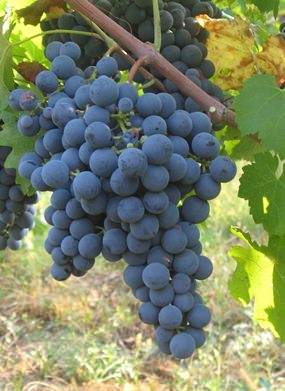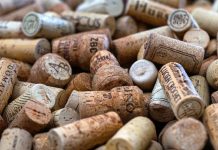Do you know how many South American countries produce wine? Or to make it easier, do you know how many countries there are in South America? Well, I thought I did, but an inspection of my slightly tattered atlas revealed that I was wrong. In fact, I was miles out. Putting aside the several dependencies, there are twelve independent countries in South America. I am not going to tell you what they are, because that’s your homework for this week. Be sure you don’t forget.
But let’s move on to the wine-producing countries. The surprising fact is that almost every country in South America produces wine, although the quality varies from top-class award-winning wines on the one hand, to rustic plonk on the other. Of course, Chile and Argentina make most of the good stuff.
 Carmenere grapes (Photo: Lebowskyclone)
Carmenere grapes (Photo: Lebowskyclone)
They’ve been producing wine since the sixteenth century, and Chile’s warm and fertile valleys and excellent climate are ideal for wine production. Argentina is one of the world’s largest wine producing countries and its wines have been improving significantly over the last couple of decades. Brazil has a rapidly-growing wine industry in the far south of the country and Uruguay produces some gritty, high-alcohol wines made largely from the French Tannat grape. Comparatively small amounts of wine are also produced in Peru, Bolivia, Guyana, Colombia and Venezuela. There’s even one small winery in Suriname, although they make it without using grapes. And come to think about it, I’ve almost done your homework for you.
Tierra del Fuego Carmenere 2011 (red), Chile (Bt. 595 @ Tesco-Lotus)
Tierra del Fuego is an archipelago off the southernmost tip of South America. It means “Land of Fire” and was discovered by Europeans in 1520 during an expedition led by the bearded Portuguese explorer Ferdinand Magellan, one of the few people in the world with the distinction of having a species of penguin named after him. This wine comes from much further north and is made from grapes grown in Chile’s fertile Central Valley. Three hundred years ago, French Carménère grapes were widely planted in Bordeaux but by the mid-nineteenth century they’d pretty well disappeared, thanks to the phylloxera plague which destroyed many of Europe’s vineyards. The Carménère grapevines were virtually wiped out and for many years the grape was presumed extinct. It was often referred to as the “Lost Grape of Bordeaux”. However, as fate would have it, Carménère eventually turned up in Chile because Chilean growers had had the presence of mind to bring home cuttings from Bordeaux before the plague struck. You won’t find many Carménère grapes in France these days, but in Chile they grow profusely and have become the country’s national grape. The Spanish-speaking Chileans usually spell it without the accents, though pronunciation guides conflict. The majority seems to favour “kahr-min-YEHR” but others prefer “KAHR-min-air-ray”. Anyway, if you’re buying a bottle in Tesco-Lotus, I don’t suppose the finer points of Spanish pronunciation matter very much.
This is a dark, purple-red wine which looks rich and syrupy in the glass. There’s a powerful and seductive floral aroma of blackberries, plums and dark fruit, vanilla, spices and herbs. The wine comes at 13% alcohol content and you might even detect the alcoholic tang (known in the wine trade as “heat”) on the nose. It’s dry, rich and full-bodied with plenty of ripe fruit on the palate and a slight touch of pepper. The mouth-feel is superbly soft and silky, no acidity to speak of, very soft caressing tannins and a splendidly long dry fruity finish. And by the way, it won an award at the UK’s prestigious International Wine Challenge so it seems that I’m not the only one who likes it.
If you enjoy full-bodied, fruity reds like an Australian Shiraz, I think you’ll like this wine. It would work with turkey or duck, roast beef or veal. It could go well with spicy food too and would even stand up to a rich and spicy Indian curry. Yes, honestly.
Baron Edmond de Rothschild Aguaribay Malbec 2011 (red), Argentina (Bt. 849 @ Big C Extra, Tesco-Lotus)
Now then, here’s a wine with a bit of class, so sit up straight and try to concentrate. I admit that the name looks a bit of a challenge but it’s fairly easy to sort out. The legendary and wealthy Rothschild banking family has been in the winemaking business for 150 years since Nathaniel de Rothschild bought Château Brane-Mouton in 1853 and modestly renamed it after himself. Even so, for generations Château Mouton Rothschild has remained one of the most exalted names in the world of wine. Today the family owns many châteaux in Bordeaux as well as wine estates across North America, South America, South Africa and Australia. However, despite this enormous expansion, the Rothschild name is still synonymous with top quality wines.
But let’s go back to the label, and in case you’re wondering, an Aguaribay is a kind of tree that grows wild in South America especially in Argentina. Malbec, of course is the grape variety, which originated in France, or so they say. It still thrives in Cahors where the locals make powerful, inky-looking Malbecs which are so heavily charged with toe-curling tannins that you wonder whether your teeth are going to work loose. In Argentina the grape is sometimes known as the Fer and in the same way that the Chileans took to the Carmenere, the Argentineans have taken Malbec to heart and it is now considered the country’s national red grape.
This is a lovely wine and also serves as a reminder of how Malbec is so different from the more well-known Merlot or Cabernet Sauvignon. It’s possible that Malbec has acquired its popularity due to the amazing variety of aromas that the grape can produce. Along with black fruits, don’t be surprised if Malbec brings you a whiff of pomegranate, plum, cocoa, coffee, leather, black pepper or even tobacco.
This very dark red wine has an elegant aroma that will caress your nose the moment you open the bottle. There are rich smells of ripe black fruits, especially blackberry and cherry, fig, oak and a touch of spice and chocolate. It has that kind of dark forest feel to it and although the wine is very dry, there’s a splendidly smooth texture and bucketfuls of rich black fruit and spices on the palate. It’s suave and full bodied with very soft tannins, yet they’re firm enough to give a sense of structure. As you’d expect from a wine of this pedigree, there’s a long dry finish with a delicate reminder of tannin. It comes at 13.5% alcohol content and would be an excellent partner for rich lean red meat dishes. It would probably work well with blue cheeses too.
Right. I think I’ve said enough for this week. And don’t forget that homework I gave you, otherwise you will encounter my displeasure. Be warned that I shall not tolerate messy handwriting and marks will be deducted for poor spelling.




